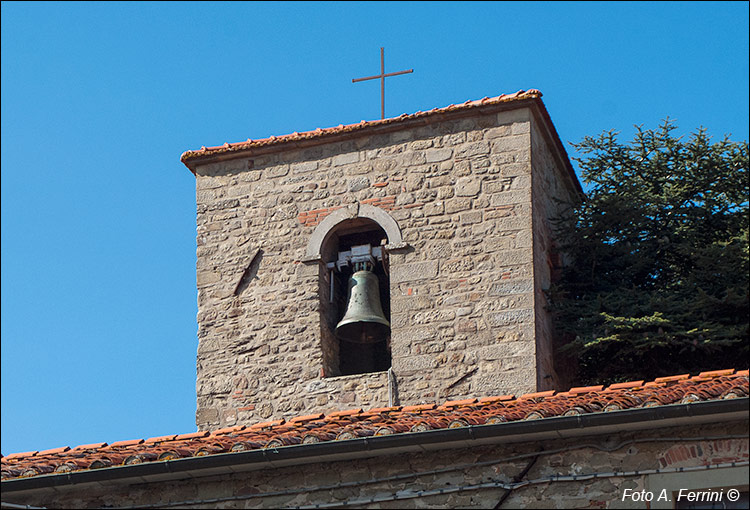Sulla via del ferro e della transumanza
itinerario sulle pendici sud Pratomagno da Pontenano al Passo della Crocina
Italiano
IN CAMMINO SU UNA VIA DELLA TRANSUMANZA 4
Il tozzo campanile della chiesa di Pontenano intitolata a Santa Margherita e San Biagio. La grossa campana che vediamo ha forma allungata e poco arcuata. Uno stile che ci riporta al medioevo. Infatti, fu realizzata nel 1352 dall'aretino Iacopo, un "ambulante" fabbricante di campane dell'epoca che le realizzava in loco con le tecnica della "cera persa". Questo è documentato sulla stessa campana: IACOPUS ME FECIT MCCCLII.
In realtà, in quell'epoca, la chiesa risultava dedicata alla sola Santa Margherita. Non si conosce il periodo in cui fu aggiunto San Biagio. Sicuramente non prima della ricostruzione cinquecentesca dopo che la chiesa originaria aveva seguito le sorti del castello di Pontenano distrutto dai fiorentini nel 1426.
San Biagio fu un vescovo armeno martirizzato con decapitazione il 3 febbraio del 316. Qualche anno prima, rifiutando di rinnegare la sua fede durante un processo cui fu sottoposto dai romani, fu torturato e straziato con quei pettini di ferro con cui si cardava la lana. Per questo è considerato il protettore dei pastori, dei cardatori e chiunque si occupi della lavorazione della lana. San Biagio, quindi, lo troviamo spesso titolare di chiese in luoghi di pastorizia, o comunque raffigurato in queste.
The squat bell tower of the church of Pontenano dedicated to Santa Margherita and San Biagio. The large bell we see has an elongated and slightly arched shape. A style that takes us back to the Middle Ages. In fact, it was built in 1352 by Iacopo from Arezzo, a "travelling" bell maker of the time who made them on site with the "lost wax" technique. This is documented on the same bell: IACOPUS ME FECIT MCCCLII.
In reality, at that time, the church was dedicated only to Santa Margherita. The period in which San Biagio was added is unknown. Certainly not before the sixteenth-century reconstruction after the original church had followed the fate of the castle of Pontenano destroyed by the Florentines in 1426.
Saint Blaise was an Armenian bishop martyred by beheading on 3 February 316. A few years earlier, refusing to renounce his faith during a trial to which he was subjected by the Romans, he was tortured and mangled with those iron combs with which wool was carded. For this reason he is considered the protector of shepherds, carders and anyone involved in wool processing. San Biagio, therefore, we often find him as the owner of churches in sheep-farming places, or in any case depicted in these.



















































































